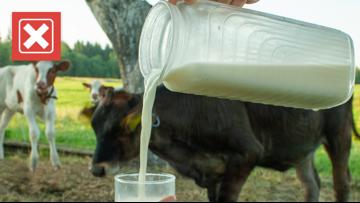Editor's note: This story is from March 2022. For the latest updates, click here.
A strain of bird flu that’s very contagious and deadly among chickens is spreading in some U.S. poultry flocks. It’s called highly pathogenic avian influenza (HPAI) A(H5N1).
As of late April, the U.S. Department of Agriculture’s Animal and Plant Health Inspection Service (APHIS) has recorded animal infections in more than two dozen states. The infected include backyard fowl, commercial poultry, pet chickens and wild birds in captivity. This marks the first time the virus has been detected in the U.S. since 2016.
According to the Centers for Disease Control and Prevention, HPAI infections have a 90-100% mortality rate in chickens, affecting multiple internal organs and causing death within 48 hours.
News of the disease prompted increased searches on Google by people wondering if the illness could infect humans.
THE QUESTION
Can the HPAI strain of avian flu currently spreading in the U.S. infect humans?
THE SOURCES
- U.S. Department of Agriculture’s Animal and Plant Health Inspection Service
- The Centers for Disease Control and Prevention
- The World Health Organization
THE ANSWER
Yes, this avian flu strain can be deadly to humans, but these infections only occur when people have close contact with sick birds, and it’s rare for the disease to spread from human to human. No cases of HPAI A(H5N1) in people have ever been reported in the U.S.
WHAT WE FOUND
As HPAI A(H5N1) spreads among backyard chicken coops and commercial poultry farms in the Eastern U.S., the Centers for Disease Control and Prevention (CDC) issued a statement saying the illness poses a “low risk to the public.”
People who don’t directly interact with birds are unlikely to catch the virus and properly cooked poultry is still safe to eat, the CDC said.
Though the HPAI A(H5N1) strain has circulated worldwide since the 1990s, no cases in humans have ever been reported in the U.S., according to the CDC and the World Health Organization (WHO).
The virus can be spread from birds to humans through contact with an infected animal’s saliva, mucus and feces, so there’s still some risk of infection for people like farmers, poultry workers or hunters who may be exposed to sick animals.
The CDC says such “sporadic” infections in humans would “not be surprising” since cases have been reported in other countries. However, an infected person is unlikely to spread the illness to another person, the agency said.
“The spread of avian influenza A viruses from one infected person to a close contact is very rare, and when it has happened, it has not led to sustained spread among people,” the statement said.
The WHO issued similar guidance, saying “the likelihood of sustained human-to-human transmission of [bird flu] viruses remains low.”
While cases in humans are rare, they can be deadly. Since 2003, the WHO collected data from more than 860 human infections occurring in 19 different countries. About 53 percent of infected people died from the illness.
The CDC recommends taking some of the following precautions when dealing with live poultry:
- Wash your hands after collecting eggs, handling birds or being in their living spaces
- Adults should supervise children as they wash their hands
- Use hand sanitizer after any contact with birds if soap and water aren’t readily available
- Don’t kiss birds or bring them close to your mouth
- Don’t bring birds into human living spaces
- Avoid getting scratched or bitten by birds
If a person does become infected with HPAI A(H5N1), antiviral medication may help treat the illness, which causes flu-like symptoms including cough and fever, according to the WHO. The CDC also says it has the blueprint for a vaccine that could protect people if the virus started spreading more widely from human to human.
Experts urge livestock farmers and backyard birders to take steps to protect their animals. Signs bird flu is spreading among backyard poultry include fewer eggs and frequent deaths, the CDC says. The Animal and Plant Health Inspection Service has resources available through its “defend the flock” program.
“The main action right now is for anyone who owns birds to take steps to help protect the health of their birds. More information on how to do that is available on our website,” a USDA spokesperson told VERIFY.
More from VERIFY: Fact-checking videos claiming to show Russia’s aerial attacks on Ukraine












